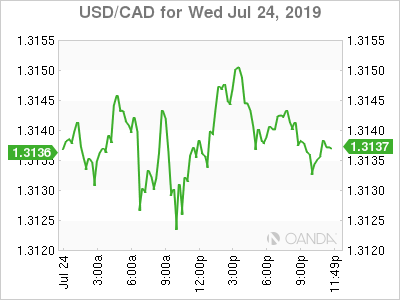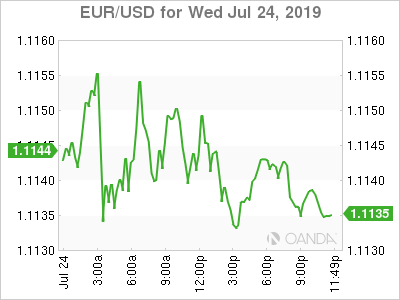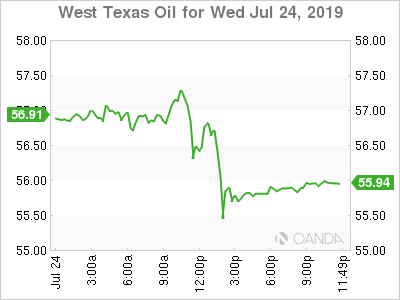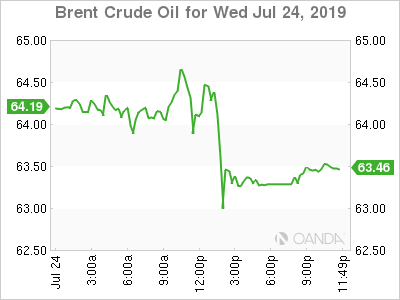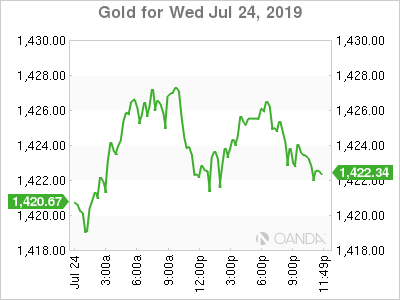The Canadian dollar traded lower versus the US dollar on Wednesday. The greenback has risen all week and stands higher against all major pairs. The soft PMI data in Europe triggered a bout of dollar buying as global growth lacks traction. The IMF downgraded global growth, but upgraded the US.
The Fed is expected to make a preemptive rate cut, while the ECB could be forced to go deeper into negative rate territory to avoid a recession. The Bank of Canada (BoC) could be pulled into action sooner rather than later if economic indicators don’t improve. At the moment the BoC enjoys some breathing room, but that could quickly evaporate if weaker data starts coming in.
Oil prices continue to be pressured downwards by low growth expectations. The US will send a team to talk trade in China next week, but energy demand has been hit as the prolonged trade war between the two largest economies does not seem close to a deal.
Central banks are ready to once again retake the spotlight in a sequel to 2008 when they shackled volatility with a coordinated slashing interest rates to near zero. The main issue facing policy makers is that now some of their actions did not bear the expected fruit and economies lie near recession despite exhausting their monetary policy toolkit.
Equity markets continue a record run on the back of lower rates, and even the mighty Fed which hiked four times in 2018 is now ready to admit defeat and walk back its monetary policy with a rate cut in July.
The prolonged trade war between US and China could be near a mutual agreement as the US delegation flies to China next week, but investors have been here before and this time more details will be needed before a big reaction is felt.
OIL
Oil prices fell on Wednesday despite the Energy Information Administration (EIA) weekly crude inventory data confirming the API numbers and showing a large drawdown last week. Weather related disruptions could have influenced the 10.8 million barrel drop in crude stocks and with crews returning to work it looks to be a temporary drop in supply.
Concerns about Middle East tensions are keeping oil prices supported as Iran has warned about the presence of naval ships out of the Persian Gulf.
The rise of US production to the point the US is now a net exporter has reduced the impact of geopolitical supply disruptions but crude is not immune to disruptions in one of the largest shipping routes in the world.
A third of oil transported by sea passing through the Strait of Hormuz.
Global growth concerns are driving energy prices lower as forecasts keep getting downgraded even as the US will be sending a trade team to China next week. US Treasury Secretary Mnuchin has already tempered expectations by saying there are still many issues to resolve.
The prolonged trade war between the US and China has been a major factor putting downward pressure on global growth and signs of a possible agreement are positive for oil.
GOLD
Gold rose 0.27 percent on Wednesday ahead of the European Central Bank (ECB) meeting later today. The yellow metal is trading at $1,424 as central banks have turned dovish with their fingers ready to trigger lower rates and other monetary policy tools to stimulate their respective economies. The ECB is not likely to act this week but the soft European PMI data, will validate a rate cut deeper into negative in the near term.
Gold has been bid as a safe haven and with the US-China trade talks moving along, but with an uncertain outcome as well as Boris Johnson as the newly stated Prime Minister of the UK, there will be plenty geopolitical risk for investors to seek refuge in the metal.
The gold rally will be vulnerable to the rhetoric of central banks, as their actions have for the most part have been priced into the asset. The ECB is likely to hold, with a future cut, while the Fed is heavily anticipated to slash its benchmark rate on July 31.
BITCOIN
The leading cryptocurrency tried to break above the $10,000 dollar price level, but did not gather enough traction as comments from US Treasury Secretary Mnuchin knocked it back to around the $9,672 level. Mnuchin said that he wouldn’t be talking about bitcoin in six years, which seems harsh specially since the Trump administration has been so adamant in depreciating the US dollar.
A lower dollar, would give rise to other investment alternatives like Bitcoin to flourish as central banks around the world once again pursue easing monetary policy.
GBP
The pound rose on Wednesday as the reality of Boris Johnson as Prime Minister set in and the euro was under fire for underperforming PMI data. The ECB will need to act sooner rather than later on rates, leaving the BoE and the pound an edge against the single currency.
The ghost of no-deal Brexit will hang around the GBP as Johnson assembles his cabinet, but the market is still giving him the benefit of the doubt when he says there is too much pessimism against Brexit at home and abroad. Maybe he will be the one to inject optimism into this messy and drawn out divorce.




